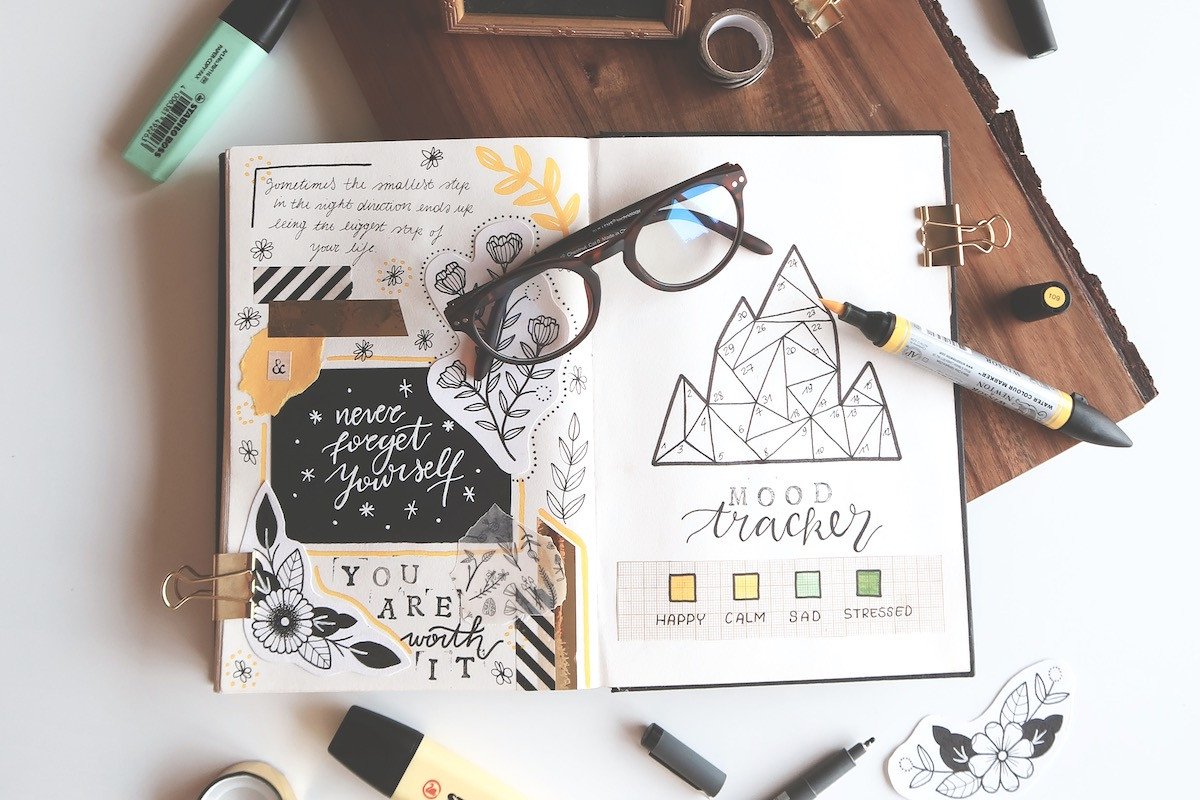Photo by SHVETS production from Pexels
Wouldn’t it be nice to picture something you want and then have it happen?
Yes, we think so, too. Unsurprisingly, things don’t really work that way. While we’ve all seen wellness or “self-help” influencers on social media touting the idea that visualization is the key to making your dreams come true, it’s not that simple.
You can’t imagine a goal you’d like to achieve and then have it happen to you—not without the hard work it takes to get there.
With that caveat, visualization has some real benefits in its truest, most scientific sense. In fact,
this article about visualization from Psychology Today explains that it can “enhance motivation, increase confidence and self-efficacy, improve motor performance, prime your brain for success, and increase states of flow.” Intriguing, right?
Table of Contents
Today, we’re discussing how to visualize—and how to use the power of visualization to your advantage in all aspects of your life.
Why Visualization Isn’t Woo-Woo
Some so-called “self-help” people we see on social media promote a kind of visualization or manifestation that feels almost like magic. And it feels magical because that kind of positive thinking is not true visualization.
A real visualization process,
according to Dr. Frank Niles, is “a well-developed method of performance improvement supported by substantial scientific evidence and used by successful people across a range of fields.”
It’s a method of thinking that we can practice to help us visualize the goals we set for ourselves and to ultimately envision the steps that we’ll need to take to make them happen.
Dr. Niles cites various athletes, including Michael Jordan and Tiger Woods, that used visualization techniques before big games.
The New York Times reported a few years ago that many Olympic athletes use visualization techniques to mentally prepare for the challenges that lie ahead—and that they may spend years imagining different scenarios that could happen in the real environment. They note that Billie Jean King was a proponent of visualization in the 1960s.
Luckily, visualization isn’t just for professional athletes or peak performers. Here’s how it works—and how you can apply it to your own life.
How Visualization Works
Assistant Clinical Professor of Psychiatry at Harvard Medical School
Srini Pillay explains that “Visualization and action are intimately connected, involving the motor cortex.” In other words, the part of the brain that gets fired up when you physically do something is the same part that gets fired up when you think about doing something.
“In fact,” he argues, “visualizing movement changes how our brain networks are organized, creating more connections among different regions...Even picturing others in motion warms up the ‘action brain’ and helps us figure out what we want to do and how we can coordinate our actions with those around us.”
When we apply this concept to other aspects of our lives, we can essentially prepare, or train, our brains to be ready to take the action we’ll need to make our goals happen.
What About the Law of Attraction?
Before we dive into the how-to part of visualization, a caveat.
Visualization can brush against some of the tenants of
the law of attraction, and this is where it’s easy to slide into the more woo-woo side of things if you’re not careful.
We logically know that simply imagining something we want isn’t going to make it appear. For example, if you’re hoping for
a major promotion and you continue to do exactly the same thing at work that you’ve been doing for the past couple of years, it’s likely not going to happen.
Just thinking of a goal you’d like to achieve leaves out arguably the most important part of visualizing: imagining the actionable steps you’ll need to take to get there.
In its loosest sense, the law of attraction says that “like attracts like”—that thinking and acting positively will cause good things to happen to you.
As much as we’d like things to be that simple, they’re not. We’re not advocating that you shouldn’t think positively and act nicely, but doing that doesn’t necessarily mean that only good things will happen to you.
That kind of thinking is problematic in another sense, too, as it places an awful lot of responsibility on the person thinking. It would be easy to slide into the mindset of blaming yourself if something bad happens to you. It’s a slippery (and unhealthy) slope.
Rather than focusing on visualization with the law of attraction in mind, it’s more useful to employ it as a means to truly think about your goals. Envision the actions you’ll take to achieve them. Focus your energy on them in a way that will build resilience and self-compassion on your journey.
How to Pick a Goal to Visualize
In order to practice visualization, you’re going to need something to—you guessed it—visualize. This is a super personal choice, of course, but it’s also probably something that you don’t have to think too hard about.
When starting out with visualization, we think it’s best to consider a
short-term goal for your first “visualization target.” That way, achieving it feels more tangible than a goal that you might not realize for five or ten years.
For example, let’s say you work in marketing and want to
switch careers and
become a project manager in a nonprofit organization. This will undoubtedly mean a lot of hard work, but having a concrete goal in mind to visualize is the starting point.
How to Start Visualizing Your Goals
Now that we’re well-versed in the benefits of visualization, let’s do it! No surprise here: a lot of it involves mental preparation.
Change Your Self-Talk
Let’s start with how we speak to ourselves. Many of us find ourselves in cycles of
negative self-talk day in and day out. All sorts of things can trigger this, but when we go about setting a goal, that negative voice might kick in and say, “I’m not good enough,” or “I can’t do this.”
To effectively visualize, you’re going to want to practice quieting down that negative inner voice so that you can truly imagine what it would feel like if and when you do reach your goal.
Find Your Motivation
In order for your visualization practice to “work,” you’re going to have to want it to work. It’s all about your mindset.
Whether or not your vision comes to fruition depends on
your own motivation and the actions you take to get there. The goal should be something you really, truly want—something that will improve your life or provide you with a healthier work life balance or allow you to
live more in your “truth.” You’re probably going to need to muster up a good bit of
intrinsic motivation for this goal—you’ll want to
define your purpose and rely on those factors that motivate you in order to really connect with what you’re visualizing.
What’s interesting to consider is that motivation and visualization kind of work in a circle: visualizing your goal can be motivating, and motivation can inspire your vision, especially as you get closer and closer to it.
Break It Into Small Pieces
Finally—and this may be the most important part—in order to actually visualize, you want to think of the entire big picture...including the small steps it takes to get to the end goal.
Back to the job change example: your end-goal visualization is picturing yourself in a project managerial role that you enjoy and that allows you to live comfortably and contentedly.
It’s those small, bite-sized visions that set “woo-woo” visualization and “real” visualization apart from one another. It’s envisioning those smaller goals and how you’ll feel as you achieve each and every one of them.
Visualize Your Past Achievements
Visualization isn’t necessarily just for future goals, either. It’s also an effective way to think back on what you’ve already accomplished. This practice can take you back to a positive mindset from a time when you felt really proud of something you’d completed.
Here’s an example of what I mean:
I gave the commencement address during my high school graduation, and I was so, so nervous.
I attended a small public school in Mississippi, and there weren’t a ton of people there, but it was the biggest crowd I’d ever seen in our high school auditorium. It might as well have been 10,000 in my eyes at the time.
But—I (shakely, scaredly) did it! After that, when I was tasked with a presentation or an assignment that required
public speaking in college, I’d envision myself delivering that commencement address. It gave me confidence (and still does when I’m in certain situations) to reflect on the fact that my 18-year-old self did that. I’ve been employing that kind of hindsight visualization for years, without even knowing it.
All of that to say: it’s genuinely helpful to
keep track of your wins—to think back on the times where you met a challenge head-on—especially as you’re moving forward to the next big thing.
Visualize Your Obstacles, Too
If you’ve watched The Queen’s Gambit, you know how effective visualizing obstacles can be. The main character, Beth, uses visualisation to play chess on her bedroom ceiling, and it helps her figure out what her opponents might do, ultimately resulting in a stronger game.
Visualizing offers an opportunity to work through the
obstacles you might encounter, and come up with solutions as to how you’d handle them. Some of the Olympians that
The New York Times spoke with explained that when they visualized a negative outcome, they’d start over and work to change what went wrong.
Try not to get into a
negative thought spiral here or start having a mental rehearsal of what could go wrong—you don’t want to ratchet up any anxiety. However, simply acknowledging some of the challenges you face may ultimately help if you do come up against them.
How to Make a Visualization Plan
Finally, here’s a six-step process that we rely on when we’re trying to visualize.
1. Understand your goal.
Back to my point above: you’ll want to have a clear-cut, ideally
short-term goal to visualize.
2. Emphasize the process.
When you visualize, think about the entire process, not just the final goal. In our job change example, this means the smaller, bite-sized steps we outlined.
3. Create a vivid picture.
4. Okay—here’s where the actual visualization practice takes place. To visualize, you’re going to want to create a realistic image of your goal (and the steps you’ll take to get there). If you’re a visual learner, you might want a real, physical picture in the form of a drawing or vision board. Otherwise, a clear picture in your mind’s eye is all you need.
4. Visualize!
This is similar to
mindfulness meditation in that you’ll need to find a moment to concentrate on your thoughts. You could do this sitting still, or it works just as well in the shower or while you’re on a walk. Essentially, you just need some time to be by yourself so you can hear yourself think. It’s kind of like
daydreaming on purpose.
When you’re visualizing, most experts say to try to focus on the five senses that you’ll feel when you achieve whatever it is you’re “seeing.” For example, it might mean thinking about the crisp, fall weather you’ll feel as you walk into your
first day in your new job.
It might be imagining the smell of the coffee you’ll have in hand. It might be thinking about the nervous butterflies you’ll feel as you walk inside.
Finally, you want to focus on your emotions when achieving your goal, like pride,
self-confidence, or a sense of accomplishment.
5. Practice.
Like mindfulness meditation, you may deal with distractions when trying to visualize. This is totally normal. You’ll just simply go back to your “vision.”
Once you’ve done this, you’ll want to do it again...and again. The best way to take advantage of a visualization session is to make it a daily practice. Imagine how cool it will feel when you achieve your vision in real life, after you’ve practiced in your head multiple times. It will make your accomplishment (no matter how big or small) sweeter.
















